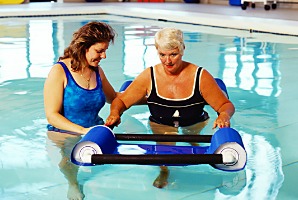Health Blog
Physical therapy proven to play a key role in stroke rehabilitation

Returning to basic activities of daily living is often the primary goal of recovery
Strokes, defined as some degree of cerebral (brain) function loss, are common in the U.S., with about 795,000 people experiencing a stroke every year. The majority of these stroke victims (about 80%) are over the age of 65, and as our aging population continues to grow, the number of strokes is expected to grow as well. The main goal of stroke rehabilitation is to help patients return to basic activities of daily living (ADLs) like feeding and self-care. Physical therapy is often prescribed as a key component of this rehab process to help this aging population recover their ADLs. Though physical therapy is widely used and generally supported by evidence, guidelines that instruct the best methods of treatment based on this evidence are slightly outdated. In order to provide optimal recommendations for physical therapy, a massive review was performed on all available literature.
Hundreds of studies are reviewed in detail
To find data for this review, medical databases were searched for randomized controlled trials (RCTs), which are powerful studies that provide reliable evidence. Each RCT had to include physical therapy to improve body functions and ADLs as part of a stroke rehabilitation program. This search turned out a total of 467 RCTs involving 25,373 stroke patients who underwent various types of physical therapy treatments, and outcomes from all trials were analyzed to determine effectiveness.
Strong evidence supports physical therapy as an effective intervention
Results from this review provided strong evidence, in the majority of treatment interventions analyzed, that physical therapy led to beneficial effects in one or more outcomes of stroke rehabilitation. Additional findings showed that treatment programs that included intense, task-specific training (relearning how to complete basic tasks) with high amounts of repetition were the most beneficial for improving outcomes. Based on these results, it appears physical therapy, with the various types of interventions it offers, should continue to play a central role in stroke rehabilitation. Furthermore, treatment programs should include the elements listed above and begin within the first month after stroke to be most effective, and it is important that stroke patients discuss treatment options with their physical therapist before proceeding with it.
-As reported in the February '14 edition of PLoS One
January 7, 2015
Back to Health BlogHEALTH BLOG
- A Personalized Physical Therapy Program Can Assist with Whiplash
- Why Older Adults Should Incorporate an Exercise Program
- After an Achilles Injury, Physical Therapists Can Help with Recovery
- AI Can Answer Questions But It’s Best to See a Physical Therapist
- Physical Therapy Can Help With Symptoms of Wryneck
- Reduce the Risk of Pickleball Fractures By Taking Proper Precautions
- Physical Activity May Slow the Progression of Parkinson's Disease
- Too Much Salt in Your Diet? Learn the Dangers of High Sodium Intake
- Suffer From Lower Back Pain? Might Be Time to Take A Break
- The Road to Recovery: Preventing Re-Injury After ACL Surgery
RECENT ARTICLES

- 11 Possible Reasons Your Back HurtsJune 22, 2020

- What Conditions Can a Chiropractor Treat?May 25, 2020

- A Simple Guide to Better PostureApril 30, 2020

- Is Acupuncture Right for Me When I’m Afraid of Needles?March 30, 2020

- Stretching Done Right — How and When to StretchFebruary 26, 2020

